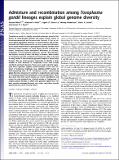| dc.contributor.author | Minot, Samuel | |
| dc.contributor.author | Melo, Mariane Bandeira | |
| dc.contributor.author | Li, Fugen | |
| dc.contributor.author | Lu, Diana | |
| dc.contributor.author | Neidelman, Wendy | |
| dc.contributor.author | Levine, Stuart S. | |
| dc.contributor.author | Saeij, Jeroen | |
| dc.date.accessioned | 2013-03-06T20:47:57Z | |
| dc.date.available | 2013-03-06T20:47:57Z | |
| dc.date.issued | 2012-08 | |
| dc.date.submitted | 2011-10 | |
| dc.identifier.issn | 0027-8424 | |
| dc.identifier.issn | 1091-6490 | |
| dc.identifier.uri | http://hdl.handle.net/1721.1/77588 | |
| dc.description.abstract | Toxoplasma gondii is a highly successful protozoan parasite that infects all warm-blooded animals and causes severe disease in immunocompromised and immune-naïve humans. It has an unusual global population structure: In North America and Europe, isolated strains fall predominantly into four largely clonal lineages, but in South America there is great genetic diversity and the North American clonal lineages are rarely found. Genetic variation between Toxoplasma strains determines differences in virulence, modulation of host-signaling pathways, growth, dissemination, and disease severity in mice and likely in humans. Most studies on Toxoplasma genetic variation have focused on either a few loci in many strains or low-resolution genome analysis of three clonal lineages. We use whole-genome sequencing to identify a large number of SNPs between 10 Toxoplasma strains from Europe and North and South America. These were used to identify haplotype blocks (genomic regions) shared between strains and construct a Toxoplasma haplotype map. Additional SNP analysis of RNA-sequencing data of 26 Toxoplasma strains, representing global diversity, allowed us to construct a comprehensive genealogy for Toxoplasma gondii that incorporates sexual recombination. These data show that most current isolates are recent recombinants and cannot be easily grouped into a limited number of haplogroups. A complex picture emerges in which some genomic regions have not been recently exchanged between any strains, and others recently spread from one strain to many others. | en_US |
| dc.description.sponsorship | Massachusetts Life Sciences Center (New Investigator award) | en_US |
| dc.description.sponsorship | Pew Charitable Trusts (Pew Scholar Program in the Biomedical Sciences) | en_US |
| dc.description.sponsorship | National Institutes of Health (U.S.) (grant R01-AI08062) | en_US |
| dc.description.sponsorship | Knights Templar Eye Foundation | en_US |
| dc.description.sponsorship | National Institute of General Medical Sciences (U.S.) (Biological Sciences 5-T32-GM007287-33) | en_US |
| dc.description.sponsorship | National Institute of General Medical Sciences (U.S.) (Training Grant T32AI060516) | en_US |
| dc.language.iso | en_US | |
| dc.publisher | National Academy of Sciences (U.S.) | en_US |
| dc.relation.isversionof | http://dx.doi.org/10.1073/pnas.1117047109 | en_US |
| dc.rights | Article is made available in accordance with the publisher's policy and may be subject to US copyright law. Please refer to the publisher's site for terms of use. | en_US |
| dc.source | PNAS | en_US |
| dc.title | Admixture and recombination among Toxoplasma gondii lineages explain global genome diversity | en_US |
| dc.type | Article | en_US |
| dc.identifier.citation | Minot, S. et al. “Admixture and Recombination Among Toxoplasma Gondii Lineages Explain Global Genome Diversity.” Proceedings of the National Academy of Sciences 109.33 (2012): 13458–13463. CrossRef. Web. | en_US |
| dc.contributor.department | Massachusetts Institute of Technology. Department of Biology | en_US |
| dc.contributor.mitauthor | Minot, Samuel | |
| dc.contributor.mitauthor | Melo, Mariane Bandeira | |
| dc.contributor.mitauthor | Li, Fugen | |
| dc.contributor.mitauthor | Lu, Diana | |
| dc.contributor.mitauthor | Neidelman, Wendy | |
| dc.contributor.mitauthor | Levine, Stuart S. | |
| dc.contributor.mitauthor | Saeij, Jeroen | |
| dc.relation.journal | Proceedings of the National Academy of Sciences of the United States of America | en_US |
| dc.eprint.version | Final published version | en_US |
| dc.type.uri | http://purl.org/eprint/type/JournalArticle | en_US |
| eprint.status | http://purl.org/eprint/status/PeerReviewed | en_US |
| dspace.orderedauthors | Minot, S.; Melo, M. B.; Li, F.; Lu, D.; Niedelman, W.; Levine, S. S.; Saeij, J. P. J. | en |
| mit.license | PUBLISHER_POLICY | en_US |
| mit.metadata.status | Complete | |
